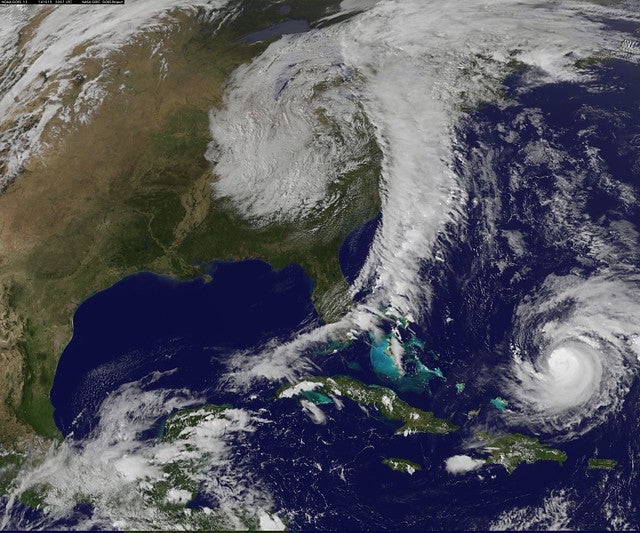August 17, 2015
From Arlene to Zeta: Remembering the Record-Breaking 2005 Atlantic Hurricane Season
Few in the insurance industry can forget the Atlantic hurricane season of 2005. For many, it is indelibly linked with Hurricane Katrina and the flooding of New Orleans. But looking beyond these tragic events, the 2005 season was remarkable on many levels, and the facts are just as compelling in 2015 as they were a decade ago.
In the months leading up to June 2005, the insurance industry was still evaluating the impact of a very active season in 2004. Eight named storms made landfall in the United States and the Caribbean (Mexico was spared), including four major hurricanes in Florida over a six-week period. RMS was engaged in a large 2004-season claims evaluation project as the beginning of the 2005 season approached.
An Early Start
The season got off to a relatively early start with the first named storm—Arlene—making landfall on June 8 as a strong tropical storm in the panhandle of Florida. Three weeks later, the second named storm—Bret—made landfall as a weak tropical storm in Mexico. Although higher than the long-term June average of less than one named storm, June 2005 raised no eyebrows.
July was different.
Climatologically speaking, July is usually one of the quietest months of the entire season, with the long-term average number of named storms at less than one. But in July 2005, there were no fewer than five named storms, three of which were hurricanes. Of these, two—Dennis and Emily—were major hurricanes, reaching categories 4 and 5 on the Saffir-Simpson Hurricane Scale. Dennis made landfall on the Florida panhandle, and Emily made landfall in Mexico. This was the busiest July on record for tropical cyclones.
The Season Continued to Rage
In previous years when there was a busy early season, we comforted ourselves by remembering that there was no correlation between early- and late-season activity. Surely, we thought, in August and September things would calm down. But, as it turned out, 10 more named storms occurred by the end of September—five in each month—including the intense Hurricane Rita and the massively destructive Hurricane Katrina.
In terms of the overall number of named storms, the season was approaching record levels of activity—and it was only the end of September! As the industry grappled with the enormity of Hurricane Katrina’s devastation, there were hopes that October would bring relief. However, it was not to be.
Seven more storms developed in October, including Hurricane Wilma, which had the lowest-ever pressure for an Atlantic hurricane (882 mb) and blew though the Yucatan Peninsular as a category 5 hurricane. Wilma then made a remarkable right turn and a second landfall (still as a major hurricane) in southwestern Florida, maintaining hurricane strength as it crossed the state and exited into the Atlantic near Miami and Fort Lauderdale.
We were now firmly in record territory, surpassing the previous most-active season in 1933. The unthinkable had been achieved: The season’s list of names had been exhausted. October’s last two storms were called Alpha and Beta!
Records Smashed
Four more storms were named in November and December, bringing the total for the year to 28 (see Figure 1). By the time the season was over, the Atlantic, Caribbean and Gulf of Mexico had been criss-crossed by storms (see Figure 2), and many long-standing hurricane-season records were shattered: the most named storms, the most hurricanes, the highest number of major hurricanes, and the highest number of category 5 hurricanes (see Table 1). It was also the first time in recorded history that more storms were recorded in the Atlantic than in the western North Pacific basin. In total, the 2005 Atlantic hurricane season caused more than $90 billion in insured losses (adjusted to 2015 dollars).
The 2005 Atlantic Hurricane Season: The Storm Before the Calm
The 2005 season was, in some ways, the storm before the current calm in the Atlantic, particularly as it has affected the U.S. No major hurricane has made landfall in the U.S. since 2005. That’s not to say that major hurricanes have not developed in the Atlantic or that damaging storms haven’t happened—just look at the destruction wreaked by Hurricane Ike in 2008 (over $13 billion in today’s dollars) and by Superstorm Sandy in 2012, which caused more than $20 billion in insured losses. We should not lower our guard.
Figure 1: Number of named storms by month during the 2005 Atlantic hurricane seasonTable 1: Summary of the number of named storms in the Atlantic hurricane basin in 2005 and average season activity through 2014
* Accumulated Cyclone Energy (ACE): a measure of the total energy in a hurricane season based on number of storms, duration, and intensity
Figure 2: Tracks of named storms in the 2005 Atlantic hurricane season
Brian Owens…





